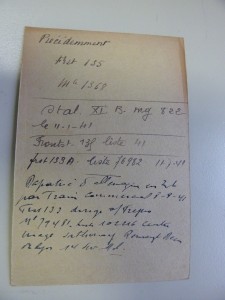written by Dr Sarah Frank (https://twitter.com/SFinParis)
—
The BAVCC or the Bureau des archives des victimes des conflits contemporains is one of the lesser-known annexes of the Sérvice Historique de la Défense or French military archives. Located in Caen, in Normandy, this small archive houses an impressive collection of material on the First and Second World Wars as well as military operations in Indochina, Algeria, Korea other external operations. It is notably a gold-mine for researchers interested in prisoners of war. For the First World War, the BAVCC has approximately 700,000 individual records for German prisoners held in France between 1914 and 1922. As far as I know, historians have never used these files.
 The staff is the best aspect of this archive: from the security officers who held on to my suitcase while I worked to the custodial staff who never complained about the mess working with crumbling cards made. Alain Alexandre and the archivists know their collections well and won’t hesitate to help find obscure references or help decrypting German handwriting. When I started visiting the BAVCC, the new fifteen-person reading room was not yet open. Instead I was given a seat in a corner and allowed to work away. Now, researchers should reserve their place in advance. The reading room does close for two hours for lunch, so plan accordingly when budgeting time. Luckily there are a plethora of cafés, crêperies, bakeries within a 5-min walk.
The staff is the best aspect of this archive: from the security officers who held on to my suitcase while I worked to the custodial staff who never complained about the mess working with crumbling cards made. Alain Alexandre and the archivists know their collections well and won’t hesitate to help find obscure references or help decrypting German handwriting. When I started visiting the BAVCC, the new fifteen-person reading room was not yet open. Instead I was given a seat in a corner and allowed to work away. Now, researchers should reserve their place in advance. The reading room does close for two hours for lunch, so plan accordingly when budgeting time. Luckily there are a plethora of cafés, crêperies, bakeries within a 5-min walk.
More information is available here: (cut and paste link)
www.servicehistorique.sga.defense.gouv.fr/Le-SHD-a-Caen.html
I went to Caen looking for information concerning colonial prisoners of war (CPOWs). These soldiers came from across the French Empire and were captured by the Germans in 1940. Statistics for CPOWs are notoriously unreliable, but the BAVCC’s records have done much to clarify their captivity experience. These records include lists of prisoner movements between camps in Germany and Occupied France, as well as detailed records for individual prisoners, mostly repatriated before 1943 and many of which include photos. Additionally, the BAVCC has two million individual ‘capture cards’ that all prisoners completed upon capture. These were then sent via the International Red Cross to the French and German authorities as an official notice of capture and location. There are 131 metal boxes of cards for the CPOWs, organised by colony and then last name. The information recorded varied widely from prisoner to prisoner. For some CPOWs we have a record of their entire captivity in Frontstalags in occupied France, illness, and eventual release. For others we can only assume they survived the war as they personally collected their pensions in the 1950s.
 In order to make use of this previously unexploited source, I spent weeks at the BAVCC making a database eventually containing 1,603 CPOWs. The flaws in the source were quickly revealed. Approximately 250,000 cards exist for about 80,000 CPOWs. Prisoners filled out a new card every time they changed camps or when ICRC representatives inspected a camp. Names were phonetically transcribed resulting in variations depending on the scribe. Sometimes last names and first names were inverted. The archivists at the BAVCC have integrated the cards using the most common spellings and duplications. Despite their enormous efforts, many prisoners remain scattered throughout the source. The cards contain other serious errors like Trân-Vân Hôi from Tonkin who was reportedly buried seven days before his death. If this were not an error it would certainly explain why he died. Despite these flaws, this source has been invaluable in establishing and challenging previous statistics on colonial prisoners of war, as well as revealing much on how these prisoners left captivity.
In order to make use of this previously unexploited source, I spent weeks at the BAVCC making a database eventually containing 1,603 CPOWs. The flaws in the source were quickly revealed. Approximately 250,000 cards exist for about 80,000 CPOWs. Prisoners filled out a new card every time they changed camps or when ICRC representatives inspected a camp. Names were phonetically transcribed resulting in variations depending on the scribe. Sometimes last names and first names were inverted. The archivists at the BAVCC have integrated the cards using the most common spellings and duplications. Despite their enormous efforts, many prisoners remain scattered throughout the source. The cards contain other serious errors like Trân-Vân Hôi from Tonkin who was reportedly buried seven days before his death. If this were not an error it would certainly explain why he died. Despite these flaws, this source has been invaluable in establishing and challenging previous statistics on colonial prisoners of war, as well as revealing much on how these prisoners left captivity.
Caen is approximately one hour and forty-five minutes from Paris St-Lazare. The full-price ticket is 36 euro one-way, but can be as low as 15 euro one-way. One can easily take an early train and arrive in Caen for 9am. From the train station, the line 1 bus will bring you to the BAVCC. Alternatively, it is about a twenty-minute walk from the centre of Caen to the archives. Most buses and the tram pass through the centre. Caen is a beautiful city with plenty of hotels for even the meagre post-graduate budget. It is well worth the trip.


